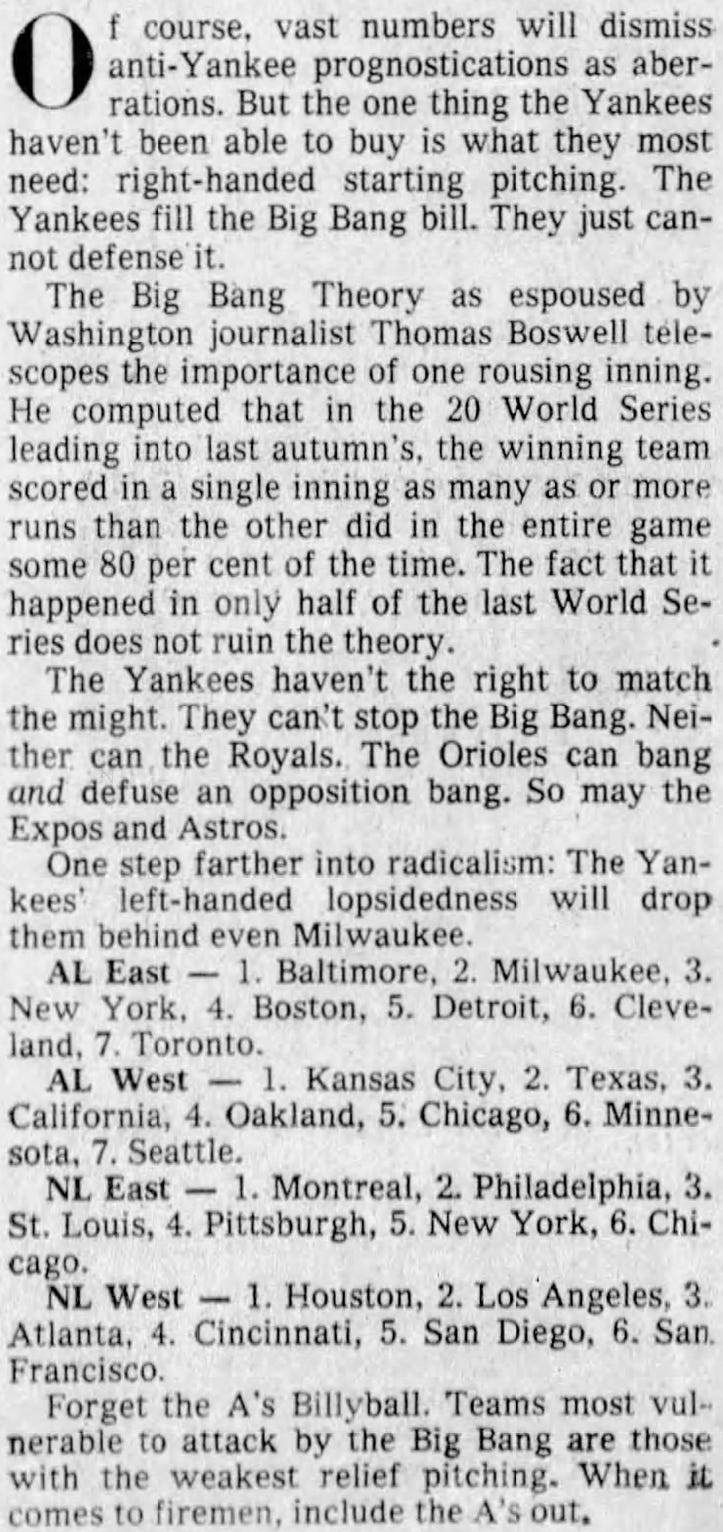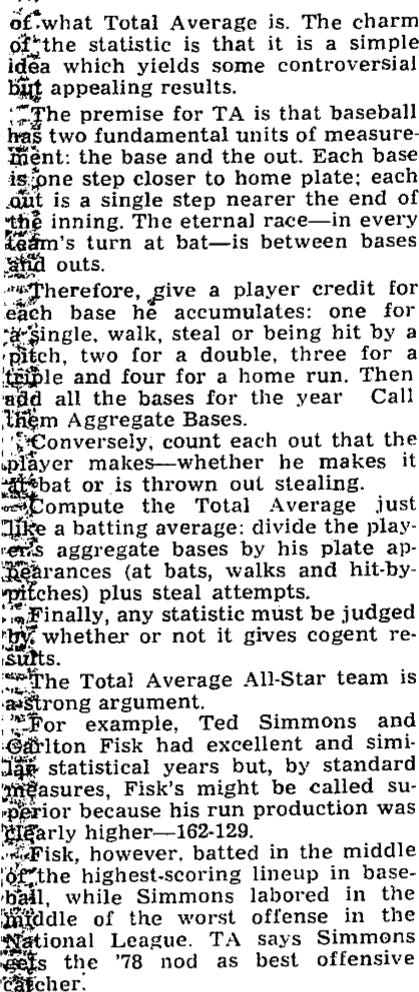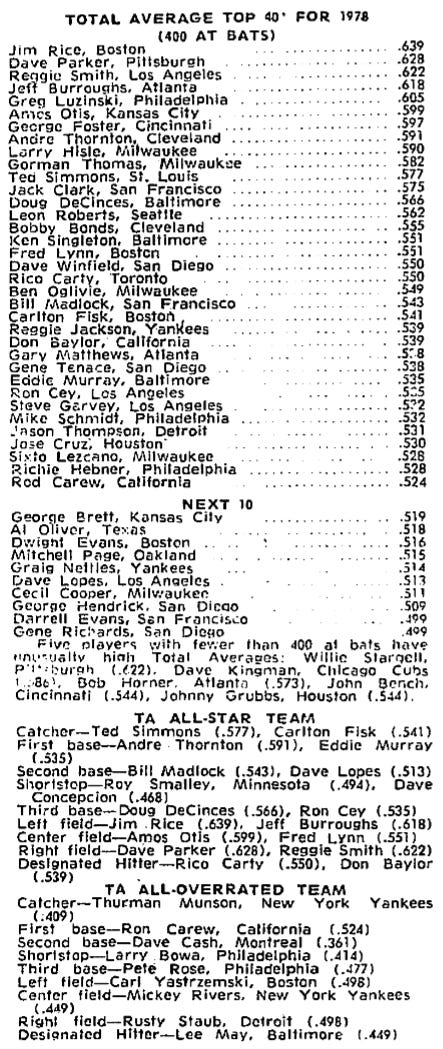The Boswell Stats
Next in our journey through the old and inaccessible writings of Bill James is this snippet from the 1981 Abstract:
I disagree with James’ characterization of Boswell as “good,” having subjected myself to many of his articles after we first moved to the Washington D.C. area years ago. But we’ll ignore that part for now.
There are two concepts here: the Big Bang Theory and Total Average.
Both came from Boswell’s newspaper columns. However, I’ve not been able to find any source for the Big Bang Theory. I blame ProQuest’s poor search engine, and truly wish that newspapers.com had the full Washington Post archives: it’s search engine is a lot better.
Boswell’s Big Bang Theory
Anyway, the Big Bang Theory of baseball goes something like this: between two teams, the better team will likely score more runs in a single inning than the other team will in the entire game.
That’s literally what Boswell says:
Boswell even offers “proof” of this:
Okay — let’s stop there. If Boswell is right, and if there really is something going on here, you’d imagine that it would be a little bit more prominent than this, right? It only holds true for a little over 70% of all World Series games from 1960 to 1980 (I’m assuming those are the years he used).
Now, you have to take this theory with the environment in which it was created. There was no team in Washington DC at the time, which meant that Boswell spent a lot of time covering the Baltimore Orioles. That meant covering Earl Weaver, who, of course, was a big proponent of the big inning.
I think most sabermetricans would agree with Weaver. Instead of pushing for a single run and sacrificing to get it, Earl was all about the three run homer, putting crooked numbers on the scoreboard, and sending the opposing starting pitcher to the showers early.
Of course, the biggest problem with this “theory,” aside from the fact that World Series games are different than regular season games, is that it doesn’t help you when you make your predictions. Take a look at this article by Edwin Pope in early 1981 for example:
I wonder what Pope thought of the Big Bang Theory when the Yankees wound up winning the 1981 World Series.
Total Average
Total Average is a more serious statistic, in my mind. It will also likely seem more natural and appealing to you.
The earliest reference I could find to it comes from April 1979. The way this article was written makes me believe that Boswell probably talked about it in an earlier article, but, since ProQuest is horrendous, it’s going to take me a while to find it.
Unfortunatley, Boswell neglected to define how his stat is calculated — a grievous sin that makes it hard to figure out what he’s talking about.
In How Life Imitates The World Series, Boswell defines Total Average as a ratio between the bases a player accumulates and the outs he gives up:
As usual, Wikipedia is helpful here:
Both of these formulas seem to be pretty sensible, right? Though the first version didn’t really use “outs” as the denominator (seems like he was calculating something more like Plate Appearances, but adding in stolen bases and times caught stealing), the final version seems to be just like what he was describing in his book. And, of course, having a Total Average of over 1.000 would be remarkable.
Of course, there’s a fundamental problem with this forumla. The problem is that offensive players aren’t just trying to accumulate bases. Furthermore, not every base is created equal.
There’s an old article from Bill James Online, one that went offline almost a decade ago, that goes into both issues. You can find it here.
We’ve already talked about the obvious issues with the Big Bang Theory. When it comes to the Total Average issues, the author of this article lays it out pretty simply:
Is that true? I’ve had arguments over the years with people on Twitter about this point. A walk is kind of good, though not always as good as a single. It’s obvious that a base hit is better than a walk, though we can’t really tell from the limited information we have here.
The second issue, of course, is how Boswell deals with stolen bases:
There is a third issue here, of course, and one that isn’t so obvious. It’s the fact that Boswell is completely ignoring defense.
That’s the same accusation we saw Bill James lay down against Earnshaw Cook the other day. You can’t just ignore what a player does defensively and look only at his offensive statistics.
The way we treat defense is extremely controversial and quite difficult, of course, and it’s going to take us a while to start unraveling all the work that has been done around it.
Boswell made a good effort, in my opinion. However, his work suffered from a lack of statistical sophistication, as well as from the unfortunate fact that he didn’t quite have access to the sort of databases we currently have access to.



















Dodgers won 1981 World Series - the infamous ‘split season’.
The pros/cons of Total Average aside, what struck me from that Boswell piece from 1978 was the the player names from that time and the style in which Bos wrote.
I was a longtime WaPo sports section reader in those years and remember reading first Shirley Povich’s column and then Boswell coverage of the O’s game from the night before. Just having two of the greatest baseball writers sharing the same sports desk was pretty awesome. George Solomon was a genius sports editor.